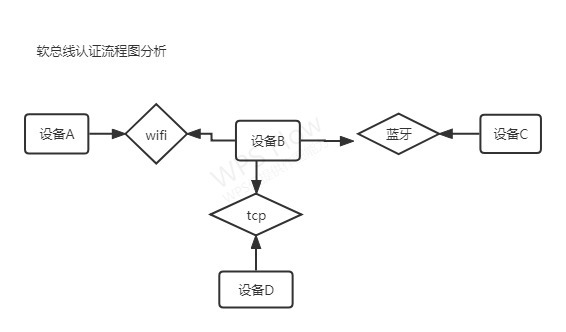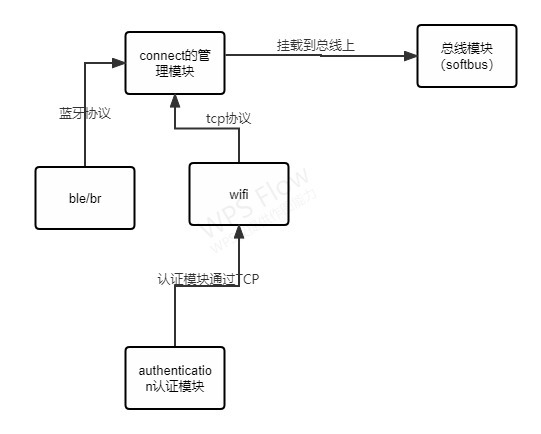openharmony软总线之--连接模块分析 原创 精华
@[toc](openharmony软总线之–连接模块分析
软总线介绍
总线(Bus)是计算机各种功能部件之间传送信息的公共通信干线,软总线与总线协议类似存在相似的功能但又又差异。总线协议中多个设备通过公共通信干线来进行通信,设备需要具备收发数据功能。openharmony 软总线需要将不同设备整合到一起,由于不同的设备通信存在差异,如wifi与蓝牙之间通信存在差异,软总线(bus)需要具备有处理不同类型设备之间通信功能。connect 模块用于这种不同类型设备管理,当然也包含于不同模块的连接管理,如认证模块,
connection模块
connection 包含的文件类型如下:
connection
│
├── ble #低功耗蓝牙
├── br #蓝牙
├── common
├── interface #外部调用接口
├── manager #设备模块接入、启停管理
└── tcp #tcp
当前设备需要支持的蓝牙/wifi/网口通信(目前蓝牙应该没有完善),其他网口和wifi 都基于tcp协议。蓝牙BLE/BR 基于蓝牙协议,因此当设备A与设备B(wifi)tcp通信时,设备A与设备c(蓝牙)同时需要具备有蓝牙通信能力。

g_connManager
ConnectFuncInterface *g_connManager[CONNECT_TYPE_MAX] = {0};
g_connManager 用于管理不同类型设备通信功能。其中支持的类似有CONNECT_TCP、CONNECT_BR及CONNECT_BLE。
typedef enum {
CONNECT_TCP = 1,
CONNECT_BR,
CONNECT_BLE,
CONNECT_TYPE_MAX
} ConnectType;
由于不同设备通信存在差异,需要通过回调来实现通信方式的配置,通信接口如下:
typedef struct {
int32_t (*ConnectDevice)(const ConnectOption *option, uint32_t requestId, const ConnectResult *result);
int32_t (*PostBytes)(uint32_t connectionId, const char *data, int32_t len, int32_t pid, int32_t flag);
int32_t (*DisconnectDevice)(uint32_t connectionId);
int32_t (*DisconnectDeviceNow)(const ConnectOption *option);
int32_t (*GetConnectionInfo)(uint32_t connectionId, ConnectionInfo *info);
int32_t (*StartLocalListening)(const LocalListenerInfo *info);
int32_t (*StopLocalListening)(const LocalListenerInfo *info);
} ConnectFuncInterface;
设备启动时通ConnServerInit 函数进行初始化。ConnInitTcp、ConnInitBr、ConnInitBle 分别对应3种通信设备类型的初始化
ConnectFuncInterface *ConnInitTcp(const ConnectCallback *callback)
{
if (callback == NULL) {
SoftBusLog(SOFTBUS_LOG_CONN, SOFTBUS_LOG_ERROR, "ConnectCallback is NULL.");
return NULL;
}
if (InitProperty() != SOFTBUS_OK) {
SoftBusLog(SOFTBUS_LOG_CONN, SOFTBUS_LOG_ERROR, "Can not InitProperty");
return NULL;
}
ConnectFuncInterface *interface = SoftBusCalloc(sizeof(ConnectFuncInterface));
if (interface == NULL) {
SoftBusLog(SOFTBUS_LOG_CONN, SOFTBUS_LOG_ERROR, "InitTcp failed.");
return NULL;
}
interface->ConnectDevice = TcpConnectDevice;
interface->DisconnectDevice = TcpDisconnectDevice;
interface->DisconnectDeviceNow = TcpDisconnectDeviceNow;
interface->PostBytes = TcpPostBytes;
interface->GetConnectionInfo = TcpGetConnectionInfo;
interface->StartLocalListening = TcpStartListening;
interface->StopLocalListening = TcpStopListening;
g_tcpConnCallback = callback;
if (g_tcpConnInfoList == NULL) {
g_tcpConnInfoList = CreateSoftBusList();
if (g_tcpConnInfoList == NULL) {
SoftBusLog(SOFTBUS_LOG_CONN, SOFTBUS_LOG_ERROR, "Create tcpConnInfoList failed.");
SoftBusFree(interface);
return NULL;
}
g_tcpConnInfoList->cnt = 0;
}
if (g_tcpListener == NULL) {
g_tcpListener = (SoftbusBaseListener *)SoftBusCalloc(sizeof(SoftbusBaseListener));
if (g_tcpListener == NULL) {
SoftBusFree(interface);
DestroySoftBusList(g_tcpConnInfoList);
g_tcpConnInfoList = NULL;
return NULL;
}
}
g_tcpListener->onConnectEvent = TcpOnConnectEvent;
g_tcpListener->onDataEvent = TcpOnDataEvent;
return interface;
}
interface 接口为tcp 通信方式的配置,ConnectDevice 连接设备,DisconnectDevice 断开连接,PostBytes 发送数据,GetConnectionInfo 获取设备端信息,StartLocalListening 启动监听,StopLocalListening关闭监听,注意,设备通过g_tcpListener 将设备挂载到软总线(bus)上面。每个设备需要通过不同端口建立起服务端和客服端模式,服务端用于监听数据请求。当有数据到来时,总线上面触发,经过一系列处理,最终通过g_connManagerCb变量获取对应数据。

typedef struct {
void (*OnConnected)(uint32_t connectionId, const ConnectionInfo *info);
void (*OnDisconnected)(uint32_t connectionId, const ConnectionInfo *info);
void (*OnDataReceived)(uint32_t connectionId, ConnModule moduleId, int64_t seq, char *data, int32_t len);
} ConnectCallback;
数据接收函数
ConnManagerRecvData
void ConnManagerRecvData(uint32_t connectionId, ConnModule moduleId, int64_t seq, char *data, int32_t len)
{
ConnListenerNode listener;
int32_t ret;
char* pkt = NULL;
int32_t pktLen;
if (data == NULL) {
return;
}
if (len <= (int32_t)sizeof(ConnPktHead)) {
SoftBusLog(SOFTBUS_LOG_CONN, SOFTBUS_LOG_ERROR, "len %d \r\n", len);
return;
}
ret = GetListenerByModuleId(moduleId, &listener);
if (ret == SOFTBUS_ERR) {
SoftBusLog(SOFTBUS_LOG_CONN, SOFTBUS_LOG_ERROR, "GetListenerByModuleId fail moduleId %d \r\n", moduleId);
return;
}
pktLen = len - sizeof(ConnPktHead);
pkt = data + sizeof(ConnPktHead);
listener.callback.OnDataReceived(connectionId, moduleId, seq, pkt, pktLen);
return;
}
软总线通信模块由不同模块组合而成,如发现,认证等,当认证模块通过connect 接入总线时,数据获取流程为:softbus-> ConnManagerRecvData-> listener.callback.OnDataReceived,可以参考总线认证一块测试用例。
当然由于当前软总线功能不完善,部分数据流程存在不完善的情况。





















好贴,感谢感谢
内容不错。点赞
点赞666
666
请问这是标准系统的软总线吗?还不完善?